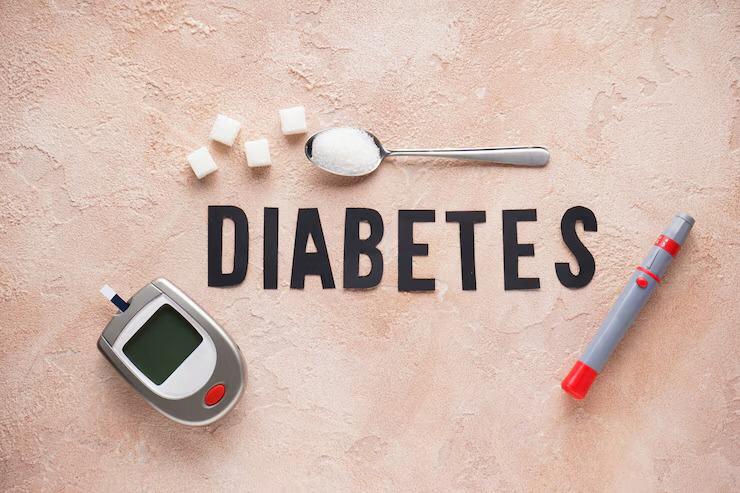Diabetes is a comprehensive guide.
Diabetes is a chronic disease characterized by elevated blood sugar levels due to insufficient insulin production, improper action, or both. It is affecting millions around the globe with severe complications of health if not managed. Awareness of diabetes, its types, and management can improve lives.
Presently Appearing Scene Regarding Diabetes in the World.
537 million adults were estimated as suffering from this ailment in the year 2021; it is anticipated that the number would rise to 783 million by the year 2045. Being the disease of the world-it brings high morbidity and mortality-therefore demanding early diagnosis and treatment.
Forms of Diabetes
There are several types which have their causes and methods of treatments.
Diabetes Type 1
Insulin-dependent diabetes is a form of autoimmune disease where the immune assault is directed against pancreatic cells, which function exclusively to secrete insulin. This disease usually occurs during childhood and in adolescence but nearly always produces a lifelong, externally dependent state of normal life through exogenous insulin.
Diabetes Type 2
It’s the most common type with 90-95% of such conditions about the body’s resistance to insulin or insulin level secretion from the pancreas. Host risk factors for developing type 2 diabetes are obesity, sedentary lifestyle, and heredity. Prevention mainly depends on changing lifestyle, medications through oral route, and sometimes insulin.
Maturity-Onset Diabetes of the Young (MODY)
Although often popularly termed as a type of common childhood sickness, MODY is actually a genetic form of diabetes developing conspicuously before the age of 25 years. Most times due to this characteristically atypical early-onset diabetes, MODY is mistakenly diagnosed as type 1 or type 2 and treated along those lines. The difference mostly lies at how many people on oral medications are insulin dependent; they usually are not. This condition requires special treatment modes that will not include insulin but can have oral medications.
Autoimmune latent diabetes in adults (LADA):
LADA is a slow autoimmune progressing type of diabetes resembling type-2 diabetes. The typical age of onset for this disease is mostly in individuals above 30 years, and the patient may eventually be required to use insulin therapy.
Gestational diabetes
Alterations of hormonal levels and, subsequently, insulin function leads to diabetes during pregnancies. Most often, it occurs only during pregnancy and resolves soon after delivery; however, it predisposes a higher risk for developing type 2 diabetes later on. Proper management is required for the benefit of the healthy mother-child dyad.
Prediabetes
Exactly, in blood sugar levels above normal but not quite fulfilling the diagnostic requirements for type 2 diabetes, which refers to it as prediabetes. This may ultimately lead to type 2 diabetes, typically as a result of cellular functions all over the body being unresponsive to insulin.
According to experts, of every 3 Americans, at least one has prediabetes, and more than 80% of the population is still oblivious to it.
Diabetes Symptoms
Of course, there are symptoms of diabetes that relate to high sugar levels within the blood.
Symptoms of general diabetes include:
Type 1, Type 2, and even Type 1.5 all basically fall under Type 1.5- shorter than the time of either Types 2 or 1.5. The latter type would show the signs much earlier into their course of disease. To put it simply, with respect to Type 2, the symptoms experienced are relatively late compared to Type 1.5. Then again, typically, a sore that does not heal quickly and tingling fibers usually characterize type 2 diabetes.
When left untreated, especially type 1, it turns into a very serious condition known as diabetic ketoacidosis, extremely high ketones in the body. Rarely seen in the other types of diabetes, but it can occur.
The most common symptoms associated with diabetes are:
Excessive hunger, excessive thirst, drop in weight, much urination, blurry vision, extreme tiredness, sores that do not seem to heal.
Importance of the C-Peptide Test
The C-peptide test itself monitors levels of C-peptide in a given blood sample, thereby measuring the production of insulin in the pancreas. This test serves to distinguish between patients with type 1 diabetes as compared to those with type 2 diabetes, diagnosing conditions such as maturity onset diabetes, appreciate diagnosis in cases of LADA, and also aids in personalizing treatment strategies.
Weight control and diabetes
That lesser body weight and effectively keeping such provides safer grounds in preventing type 2 diabetes. Such evidence shows that if a person loses 5 to 10 percent of body weight, it can play quite a dramatic role in improving insulin sensitivity and blood sugar control. Here are guidelines on weight management:
Regular physical activity – It should be performed moderately with a minimum of about 150 minutes a week.
A healthy but balanced diet – It’s important to eat healthy, although nutrient-dense non-starchy vegetables with lean proteins and whole grains and beneficial fats.
Behavioral Support – Observe emotional eating and develop behaviors that are supportive.
Good blood sugar management through carbohydrates:
Broccoli: It produces sulforaphane which aids in glucose metabolism for a person.
Healthy fats: Must from diet include almonds, seeds, and olive oil.
Porter Control: do not fill your stomach completely with large chunks of food. Avoid simple carbohydrates and sugars, and cut back on sedatives-like sugary soft drinks, confectioneries, and further processed foods.
Best on the effective management of diabetes in people by delivering the following:
These are all known top notch ways to very effectively affect diabetes management. Changing blood glucose levels, reducing sufferings, as well as pen-putting a healthier life beyond medication, are all key features in this diet.
Those are most important in dietary methods.
Low Glycemic Index Foods:
Low Glycemic Index Foods, meaning all whole grains and two legumes, starchy vegetables; almost keep afloat the blood sugar at such a level.
Smart Food Choices: Studies prove that cinnamon, Greek yogurt, and broccoli may naturally lower blood sugar levels.
Cinnamon: The insulin sensitivity augments and decreases fasting blood glucose.
Greek Yogurt: This is rich in proteins and has low carbohydrates that would make it possible to effectively manage blood sugar levels:
Broccoli: That has sulforaphane which helps glucose metabolism.
Healthy Fats: Added must almonds, seeds, and olive oil into diet.
Take Porter Control: do not eat big meals. Avoid Refined Carbs and Sugar.
Limit Refined Carbs and Sugars:Cut down on sugary soft drinks, confectionery, and further processed food.
Research on Diet and Diabetes
Draw up a diet for managing Diabetes in Patients
Here all known best ways come to be managed diabetes as much as is possible. Those are blood sugar level changers, pain reducers, and pen-out healthier existence beyond medication-cum-prioritized features of this diet.
Many important studies on diet-related aspects of managing diabetes consider nutrition as one of the management strategies, for example:
Mediterranean diet.The Mediterranean diet of healthy fats, whole grains, and vegetables has been shown to ameliorate glycemic control and lower cardiovascular risks.
Low-carbohydrate and high-protein diets.
High protein low carbohydrate diets have been effective with blood glucose control and weight reduction.
Lower Blood Sugar Levels Naturally
These patients have died, who themselves tried to stay well without medications or insulin yet eating well and following their sugar levels with type 2 diabetes. Here are the essentials in the foods that really helped them control the sugar levels.
- Avocado: Good fats keep the level even.
- Chia Seeds: High fiber and omega-3 slow sugar absorption.
- Berries: High in antioxidants; low glycemic index.
- Bright leafy greens: Nutrient-rich and low in carbohydrates.
- Legumes: Complex carbs and proteins for more long-lasting energy.
Diverse Diabetes Treatment among Different Demographics
Men
Diabetic men are sometimes subject to conditions such as erectile dysfunction and deficient testosterone levels. The best potential solution to such difficulties is a proper diet, which is high in zinc from nuts and seeds, alongside exercise.
Women
Diabetic women mainly deal with ailments such as hormonal changes, PCOS, and gestational diabetes but which the proper management is during the pregnancy not to have any complications. Consumption of leafy greens, legumes, and berries helps in maintaining stable levels of blood sugar.
Kids With Diabetes
Children with diabetes, especially type-ones need maximum care and nurturing. Having a balanced diet and educating them on ways to eat healthily is important. They should have fun and appealing options like fruit salads and whole-grain snacks for better adherence to a diabetes-friendly diet.
General Diabetes Prevalence.
537 million adults would be diagnosed as having diabetes worldwide by 2021, which is expected to climb to nearly 783 million by 2045. Diabetes, indeed, is a truly global disease and one among those that really contribute to most specific-death-rate morbidity and mortality, requiring early identification and then treatment.
It is a truly universal ailment actually accompanying other ailments and causing a lot of cases with serious morbidity and mortality and calling for very early identification and treatment.
Dieting Without Insulin
Insulin is central in type 1 diabetes; however, diets alone may suffice to manage type 2 diabetes in some cases. Patients may have to strive for natural glucose regulation by eating low-hydrating foods, timing meals consistently, and ensuring portion sizes. Nevertheless, all these should be supervised by health professionals.
Exercise and Diabetes
Besides employing a diet and effective treatment, exercise is good management for the disease-Hyperglycemia which mostly suits all kinds of diabetes.
It is a fact that exercise does a greater deal in making your body’s cells more responsive to insulin and consequently lowering blood sugar levels. Exercising regularly can also help you do the following:
- Achieve and maintain healthy body weight
- Reduce the risk of serious complications related to diabetes
- Keep up spirits
- Improve sleep
- Enhance memory
For individuals with diabetes type one or type two, general advice recommends at least 150 minutes of moderate-intensity exercise each week. Presently, there are no specific exercise guidelines for individuals having gestational diabetes; however, if you happen to be pregnant, start slow and build up the activity with time to avoid incurring too much activity.
Exercises for Diabetes include:
- Walking
- Swimming
- Dancing
- Cycling
Talk with your doctor about how to safely include activity in your diabetes management plan. You may have to take special precautions for example checking your blood sugar before and after a workout and staying well hydrated.
Consider working out with a certified personal trainer or exercise physiologist experienced in working with individuals living with diabetes. They can help you design a workout program customized to your unique needs.
Which diabetes can be treated with diet?
There are some forms of diabetes that can be managed solely through diet. The majority of patients living with type 2 diabetes usually lose weight in order to lower their blood sugar levels. Among the many advantages of weight loss is improved health overall. For those requiring weight loss, wise eating will give an organized approach to doing this safely.
What does the diabetes treatment plan consist of?
To begin with, one could take insulin or any other diabetic medicine, along with every other healthy choice of food and beverage, regular exercise, adequate sleep, and stress management; but, if all that doesn’t suffice, then taking medicines in addition will help you manage the problem. Apart from these, there are also other treatment options available.
What is the most suitable food for diabetes patients?
One-fourth of your plate must hold carbohydrates rich in high fiber, such as brown rice, whole grains, beans, or fruits. The rest of your plate should have protein foods like lean meats, fish, dairy, and of course, tofu or other soy products.

